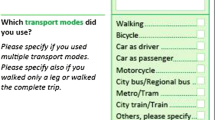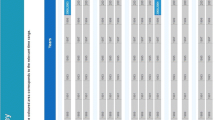Abstract
The recent shift in transport policy towards travel demand management has directed the attention of transport research towards the dynamic processes in travel behaviour; learning and change on the one hand and rhythms and routines on the other. Progress in the understanding of these processes requires from observation or self-reports data over long duration. The survey reported here provides for the first time in 30 years a data source which allows these issues to be addressed. The project Mobidrive, funded by the German ministry of Research and Education, conducted a six-week continuous travel diary with the aim of analysing the rhythms in the behaviour of the respondents. The paper describes the implementation of this travel diary survey, which was conducted in Karlsruhe and Halle, two German cities of about 270,000 inhabitants each, in the autumn of 1999. A total of 317 persons over 6 years of age in 139 households participated in the main study. The description covers the development of the forms, the design of the survey protocol, the screening experiences (including participation rates) and an assessment of the data quality in terms of item/unit non-response and reporting fatigue. The paper closes with an outlook for the analyses possible with the data set.
Similar content being viewed by others
References
Axhausen KW (1990) A simultaneous simulation of activity chains. In: Jones PM (ed.) New Approaches in Dynamic and Activity-based Approaches to Travel Analysis (pp. 206-225). Aldershot: Avebury.
Axhausen, KW (1995) Travel Diaries: An Annotated Catalogue, 2nd Edition, Working Paper, Institut für Strassenbau und Verkehrsplanung, Leopold-Franzens-Universität, Innsbruck.
Axhausen KW (2000) Definition of movement and activity for transport modelling. In: Hensher DA & Button KJ (eds.) Handbook of Transport Modelling, I (pp. 271-284). Oxford: Elsevier.
Axhausen KW & Herz R (1989) Simulating activity chains: A German approach. ASCE Journal of Transportation Engineering 115(3): 316-325.
Bradley M, Bowman JL & Lawton K (2000) Application of microsimulation techniques in activity based transportation modelling, paper presented at the 79th Annual Meeting of the Transportation Research Board, Washington, DC, January 2000.
Bhat CR (1996a) A hazard based duration model of shopping activity with nonparametric baseline specification and nonparametric control for unobserved heterogeneity. Transportation Research 30B(3): 189-207.
Bhat CR (1996b) A generalized multiple durations proportional hazard model with an application to activity behaviour during the evening work-to-home commute. Transportation Research, 30B(6): 465-480.
Brög W, Meyburg AH & Wermuth MJ (1983) Development of survey instruments suitable for nonhome activity patterns. Transportation Research Record 944: 1-12.
Cambridge Systematics (1996) Data collection in the Portland, Oregon metropolitan area, report for the Travel Model Improvement Program, Department of Transportation, Cambridge Systematics, Oakland.
Department of Transport (1994) National Travel Survey 1991/93, Directorate of Statistics, Department of Transport, HMSO, London.
Doherty ST & Miller EJ (1997) Tracing the household activity scheduling process using a one week computer-based survey, paper presented at The Eighth Meeting of the International Association of Travel Behaviour Research: Challenges and Opportunities in Travel Behaviour Research and Applications, Austin, September 1997.
Erl E (1998) The new KONTIV-design, presentation at the 3rd MEST and TEST Workshop, Pörtschach, September 1998.
Ettema D, Borgers A & Timmermans HJP (1995) Competing risk hazard model of activity choice, timing, sequencing and duration. Transportation Research Record 1493: 101-109.
Fraschini E & Axhausen KW (2001) Day on day dependencies in travel: First results using ARIMA modelling, Arbeitsberichte Verkehrs-und Raumplanung 63, Institut für Verkehrsplanung, Transporttechnik, Strassen-und Eisenbahnbau, ETH Zürich, Zürich.*
Gärling T (1998) Behavioural assumptions overlooked in travel choice modelling. In de Ortuzar J, Hensher D & Jara-Diaz S (eds.) Travel Behaviour Research: Updating the State of Play (pp. 3-18). Oxford, Elsevier.
Gärling T, Kalen T, Romanus J & Selart M (1998) Computer simulation of household activity scheduling. Environment and Planning A 30(4): 665-679.
Gawronski G & Sydow H. (1999) Wertorientierungen und Präferenzmuster: Vorstellung eines zweidimensionalen Wertesystems zur Beschreibung potentieller Kundengruppen, presentation at 20th Kongress für angewandte Psychologie, October 1999, Berlin.
Golob TF (1996) A model of household demand for activity participation and mobility. In: Gärling T, Laitilla T & Westin K (eds.) Theoretical Foundations of Travel Choice Modelling (pp. 365-398). Oxford: Pergamon.
Golob TF & van Wissen zL (1989) A joint household travel distance generation and car ownership model. Transportation Research 23B(6): 471-491.
Götz K, Jahn T & Schultz I (1997) Mobilitätsstile: Ein sozial-ökologischer Untersuchungsansatz. Forschungsbericht Stadtverträgliche Mobilität 7, Forschungsverbund City:mobil, Frankfurt am Main.
Hanson S & Burnett KO (1981) Understanding complex travel behavior: measurement issues. In: Stopher PR, Meyburg AH & Brög W (eds.) New Horizons in Travel-Behaviour Research (pp. 207-230). New York: Croom Helm.
Hanson S & Hanson P (1981) The travel-activity patterns of urban residents: dimensions and relationships to socio-demographic characteristics. Economic Geography 57(3): 332-347.
Hanson S & Huff JO (1986) Classification issues in the analysis of complex travel behaviour. Transportation 13(3): 271-293.
Hanson S & Huff JO (1988) Systematic variability in repetitious travel. Transportation 15(1-2): 111-135.
Herz R (1983) Stability, variability and flexibility in everyday behaviour. In: Carpenter S & Jones PM (eds.) Recent Advances in Travel Demand Analysis (pp 385-400). Gower, Aldershot.
Huff JO & Hanson S (1986) Repetition and variability in urban travel. Geographical Analysis 18(2): 97-114.
Joh CH, Arentze TA & Timmermans HJP (2001) A position-sensitive sequence-alignment method illustrated for space-time activity-diary data. Environment and Planning A 33(2): 313-338.
Jones PM & Clarke MI (1988) The significance and measurement of variability in travel behavior. Transportation 15(1): 65-87.
Jou R-C & HS Mahmassani (1996) Comparability and transferability of commuter behaviour characteristics between cities: Departure time and route-switching decisions. Transportation Research Record 1556: 119-130.
Jou R-C & Mahmassani HS (1997) Comparative analysis of day-to-day trip-chaining behaviour of urban commuters in two cities. Transportation Research Record 1607: 163-170.
König, A., Schlich R & Axhausen KW (2000) Deskriptive Darstellung der Befragungsergebnisse des projekts Mobidrive, Arbeitsberichte Verkehrs-und Raumplanung, 37, Institut für Verkehrsplanung, Transporttechnik, Strassen-und Eisenbahnwesen, ETH Zürich.
König, A, Schlich R, Aschwanden A, Kaufmann A & Axhausen KW (2000) Mobidrive: Data format guide, Arbeitsberichte Verkehrs-und Raumplanung, 35, Institut für Verkehrsplanung, Transporttechnik, Strassen-und Eisenbahnwesen, ETH Zürich.
Kutter E (1973) A model for individual behaviour. Urban Studies 10(2): 235-258.
Mahmassani HS (1997) Dynamics of commuter behaviour: Recent research and continuing challenges. In: Stopher PR & Lee-Gosselin MEH (eds.) Understanding Travel Behaviour in an Era of Change (pp. 279-313). Oxford: Pergamon.
Mahmassani HS, Hatcher SG & Caplice CG (1997) Daily variation of trip chaining, scheduling and path selection behaviour of work commuters. In: Stopher PR & Lee-Gosselin MEH (Hrsg.) Understanding Travel Behaviour in an Era of Change (pp. 351-379). Oxford: Pergamon.
Ortuzar J de and Willumsen LG (1994) Modelling Transport. Chichester: Wiley.
Pas EI (1983) A flexible and integrated methodology for analytical classification of daily travelactivity behavior. Transportation Science 17(4): 405-429.
Pas EI (1986) Multiday samples, parameter estimation precision and data collection costs for least squares regression trip-generation models. Environment and Planning A 18(1): 73-87.
Pas EI (1987) Intrapersonal variability and model goodness-of-fit. Transportation Research 21A(6): 431-438.
Pas EI & Harvey AS (1997) Time use research and travel demand analysis modelling. In: Stopher PR & Lee-Gosselin MEH (eds.) Understanding Travel Behaviour in an Era of Change (pp. 315-338). Oxford: Pergamon.
Pas EI & Koppelman FS (1986) An examination of the determinants of day-to-day variability in individuals' urban travel behavior. Transportation 13(2), 183-200.
PTV, AG, Fell B, Schönfelder S & Axhausen KW (2000) Mobidrive Questionaires, Arbeitsberichte Verkehrs-und Raumplanung, 52, Institut für Verkehrsplanung, Transporttechnik, Strassen-und Eisenbahnbau, ETH Zürich, Zürich.*
Recker WW & McNally MG (1985) Travel/activity analysis: pattern recognition, classification and interpretation. Transportation Research 19A(4): 279-296.
Richardson A, Ampt E & Meyburg A (1995) Survey Methods for Transport Planning. Melbourne: Eucalyptus Press.
Schlich R, König A & Axhausen KW (2000) Stabilität und Variabilität im Verkehrsverhalten. Strassenverkehrstechnik 44(9): 431-440.
Schmiedel R (1978) Methoden zur Analyse periodischer Komponenten von Zeitreihen. Institut für Städtebau und Landesplanung, Universität Karlsruhe.
Statistical Solution (1999) SOLAS for missing data 2.0, Handbook, Statistical Solutions, Cork.
Srinivasan KK & Mahmassani HS (2000) Modeling inertia and compliance mechanisms in route choice behavior under real-time information. Transportation Research Record 1725: 45-53.
Tukey JW (1977) Exploratory Data Analysis. New York: Addison-Wesley.
Webber MJ (1979) Urban Spatial Structure: An Information Theoretic Approach, report to the Social Sciences and Humanities Research Council (Canada), Project 410-77, Department of Geography, McMaster University, Hamilton.
Author information
Authors and Affiliations
Rights and permissions
About this article
Cite this article
Axhausen, K.W., Zimmermann, A., Schönfelder, S. et al. Observing the rhythms of daily life: A six-week travel diary. Transportation 29, 95–124 (2002). https://doi.org/10.1023/A:1014247822322
Issue Date:
DOI: https://doi.org/10.1023/A:1014247822322




